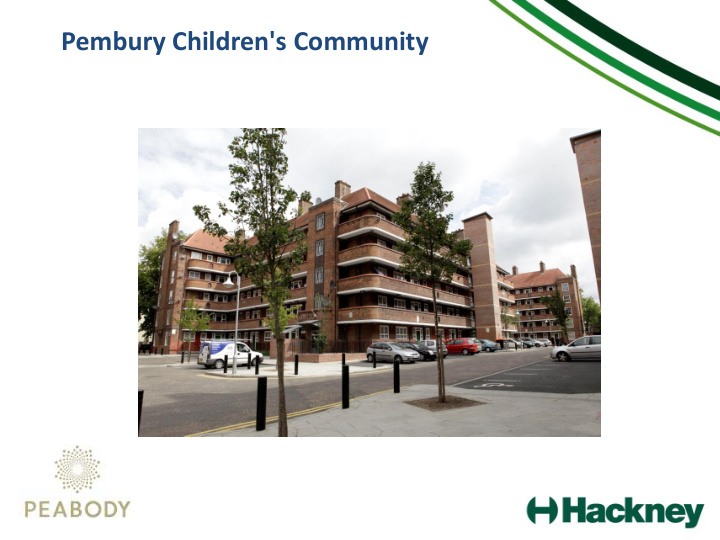



Pembury Children's Community
Local Context Hackney - An inner London borough with a young and diverse population, a burgeoning local economy, quality schools and a changing demographic. Set against the backdrop of pockets of persistent and significant deprivation that limit the life chances of some of its young residents. Pembury – A large estate of approximately 2400 residents located in the Hackney Central ward that very much reflects the challenges and opportunities that face the borough as a whole.
Partnership • Between Peabody (landlord for the Pembury estate) and the London Borough of Hackney • 2011 disturbances provided a catalyst for a joint focus on the Pembury • A shared vision was developed, taking inspiration from the Harlem ‘Children’s Zone’ in New York. Over the last 40 years, this has aimed to transform children’s chances in Harlem by working across family, school and community lives and throughout their childhood from conception to career (see http://hcz.org)
Vision “Pembury, our beacon in Hackney, will be a vibrant and aspirational place to live, because it is: • Safe and attractive • A community that is ambitious • A place where children achieve and are surrounded by positive role models” We hope to develop a powerful model that can be used on other estates both in Hackney and across Peabody. Pembury has also become one of four Save the Children pilots trailing the development of ‘Children's Communities’ in the UK. • •
Approach • Support for children from birth to early adulthood across their family, school and community lives • Concentrated focus on a specific geographic area over 10 years • Co-ordinated holistic service provision across all sectors and organisations • In depth understanding of family and child circumstances and need • Fully involving the community in designing and implementing solutions
Developing the Children’s Community • Strengthening the existing services on the estate • Set up Children’s Community Board • Development of a pilot project working with ‘NEET’ young people • Consultations with stakeholders, including families and children • Development of a ‘theory of change’ for the programme, working with the University of Manchester – the national evaluators for Children’s Communities
2. THE PEMBURY CHILDREN’S COMMUNITY 1. THE STARTING SITUATION ON THE PEMBURY ESTATE Outcomes Presenting problems 10 year vision Underlying issues A reduction in child poverty Concentrated poverty Pembury, our Beacon in e.g. (particularly through increases in - 47% of households below 60% of Hackney, will be a vibrant well-paid parental employment) the median income and aspirational place to - lack of affordable childcare, - 46% of children in poverty live because it is: particularly after-school Reduction in evictions - 35% homes overcrowded provision • Safe and attractive Improvements in educational Some children and young people - lack of jobs inc those that are engagement and achievement • under-achieving in education A community that is part-time/flexible hours (21 % of ambitious working age population are Parents feel more confident and 36% of 5 year olds not achieving a claiming benefits. Low rates of skilled in their parenting role, and • ‘good level of development’ A place where children maternal employment?) better supported by their co- achieve and are parents, by the community and by 22% of all adults on the estate have surrounded by positive - low paid work services no qualifications role models - challenges facing 1 st generation Young children develop well and Negative self and external migrants (50% of residents born are ‘school - ready’ at 4 perceptions outside UK, 43% outside EU) eg language barrier, lack of No place stigma (residents, Pressures on/within families networks, knowledge of UK particularly children, view the E.g. 58% of children on the estate in employment market, estate as a positive place to live lone parent families. discrimination, qualifications not and the external reputation of the recognized) estate is improved) Children feel confident about Local services themselves and feel able to access services and opportunities Extensive but more joining up needed Continued challenge to reach/engage the most vulnerable Balance of reactive rather than preventative services Schools under pressure – narrowly focused
Early Priorities Four key priorities have been agreed as a focus in the first three years of the programme: • Tackling child poverty – increasing employment/employability • Supporting parents – informal networks of parents, relationships between parents, parent training and support for most vulnerable families • Early Years - perinatal support, school readiness, family literacy • Transition to adulthood – partnerships with secondary schools and work with ‘NEET’ young people
The Pembury Pathways Project seeks to tackle the multiple Good quality Improved parental barriers to employment that parents face by linking together (well paid, wellbeing flexible) family support, employment & skills advice and quality childcare employment opportunities available Increase in parental skill levels, qualifications and employment Barriers to ed/training/ Parents Parents Case worker work arising enabled to supported to provides Parents Employment from family & pursue learn/train/ family support become is sustained personal issues employment work and ongoing employed Raised incomes reduced opportunities mentoring as needed Income raised/debt reduced where possible Children’s Parents outcomes improve Employment access child pays enough to care sustain Childcare childcare? brokerage inc initial subsidies and/or additional childcare spaces Good quality KEY created and Blue boxes = work to be done by the project childcare prioritised for Green boxes = intermediary outcomes for the project available in the Pembury parents Purple boxes = ultimate outcomes for the project area Yellow boxes = external variables important to the success of the project that are entirely or partially outside its scope
Recommend
More recommend